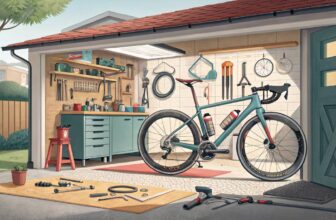Factors Affecting Bike Fit
Figuring out the right bike size by using a calculator isn’t just a good idea—it’s a game-changer for comfort and performance. This section tackles two biggies that make a bike fit just right: why frame size matters and how top tube length plays into the whole comfy puzzle.
Importance of Frame Size
Frame size is like the backbone of a smooth bike ride—get it wrong, and you’ll definitely know it. Road bike sizes usually come down to your height, though your leg length and how you like to ride also shake things up. Adult bikes get their name from their frame size, with road bikes taking the centimeter route and mountain bikes sticking to inches.
Need a cheat sheet? Here’s a quick look at how road bike frames match up with heights:
| Rider Height (ft./in.) | Road Bike Frame (cm) |
|---|---|
| 5’0″ – 5’3″ | 48 – 51 |
| 5’3″ – 5’6″ | 51 – 54 |
| 5’6″ – 5’9″ | 54 – 56 |
| 5’9″ – 6’0″ | 56 – 58 |
| 6’0″ – 6’3″ | 58 – 60 |
| 6’3″ – 6’6″ | 60 – 63 |
And if you’re hitting the trails:
| Rider Height (ft./in.) | Mountain Bike Frame (in.) |
|---|---|
| 5’0″ – 5’4″ | 13 – 15 |
| 5’4″ – 5’7″ | 15 – 17 |
| 5’7″ – 5’10” | 17 – 19 |
| 5’10” – 6’0″ | 19 – 21 |
| 6’0″ – 6’3″ | 21 – 23 |
| 6’3″ – 6’6″ | 23 – 25 |
Top Tube Length Consideration
Let’s talk about top tube length—ever heard of it? It’s basically how long the part of the bike that runs from the seat to the handlebars is. It’s pretty crucial because it’s tied to your arm and torso length.
Get the top tube length just right, and you’re golden—a comfy seat and smooth handling are yours. Too short, and you’re all squished up; too long, and you’re overreaching, which isn’t fun for anyone.
Different bikes are built for different needs. Road bikes are great on smooth surfaces, mountain bikes are the kings of off-road, and city bikes can do it all, whether you’re heading to work or just cruising around town.
BMX bikes have their own thing going on with top tube and wheel sizes. They range from 12 to 24 inches and cater to parks, trails, or street biking, depending on what you’re into (BikeFair).
Want more scoop on fitting a bike just right? Check out our guides on bike frame sizing and bike geometry explained. If it’s time for a new ride, our bike price guide and compare bike specs can be your go-to resources.
Key Measurements for Bike Sizing
Choosing the right bike size isn’t like trying on your usual pair of shoes; a little more goes into it. Part of finding that perfect fit hinges on how well you get into these pair of measurements: reach and stack height. Nailing these ensures utmost comfort, zooming efficiency, and solid bike-riding performance. Get a grip on these and you’ll find playing around with a bike size calculator a breeze.
Reach Measurement
Not having to stretch too far to grab the handlebars? That’s reach for you—your body’s friend on the bike. This takes into account the horizontal distance from the bottom bracket to the top of the head tube. Getting it just right keeps your ride cozy and your posture as fresh as the first leg of your journey, sparing your back and arms from unnecessary agony.
According to Cyclingnews, reach showcases its importance when trying to compare various bikes, helping you zero in on the right size.
| Bike Size | Reach (cm) |
|---|---|
| Small | 37 – 38 |
| Medium | 39 – 40 |
| Large | 40 – 41 |
Stack Height Influence
A kindred cousin to reach, stack height is a vertical measure from the bottom bracket up to the center of the head tube. It plays a part in defining how the rider perches on the bike. A lofty stack might seem friendlier for those enjoying casual, longer rides or who are just starting out, while adventure-seeking racers might lean towards a shorter stack for that slick, aerodynamic posture.
| Bike Size | Stack (cm) |
|---|---|
| Small | 53 – 54 |
| Medium | 55 – 56 |
| Large | 57 – 58 |
These numbers aren’t just random digits—they guide first-time buyers, seasoned cyclists, or parents looking to size up a bike for the family. Getting the right fit amplifies comfort and pumps up performance. And if you’re curious about bike mechanics, dive into bike geometry explained or explore how to compare bike specs.
Understanding Bike Geometry
Picking out a bicycle ain’t just about the color or price tag. You’ve got to know the nitty-gritty of its build—every angle and line that shapes your ride. The frame’s geometry guides how you’ll roll, come rain or shine. Two angles that really set the pace are the seat tube angle and the head tube angle. Let’s break them down.
Seat Tube Angle
Picture the seat tube angle as the seat tube making a handshake with the ground. This angle isn’t just for show; it tells your body how to sit and how your legs will spin those pedals. A steep angle pushes you over the pedals, setting the stage for a lively sprint perfect for race day. On the flip side, a gentler angle lets you take it easy, stretching out those legs for more scenic adventures.
| Seat Tube Angle | Vibe | Why You’d Dig It |
|---|---|---|
| 75° – 78° | Racing | You’re in for a power-packed, lean-forward ride |
| 70° – 74° | Touring/Chillin’ | Get comfy and go the distance without breaking a sweat |
Choosing your seat tube angle helps you match your ride to your style. Want more tips on nailing that spot-on bike fit? Dive into our bike frame sizing guide.
Head Tube Angle Impact
The head tube angle is like the brain of your steering. This is where your bike’s smarts come into play. A steeper angle quickens your steer, making it perfect for slicing through the air on a racing bike. But if life’s journey takes a more leisurely pace, a slacker angle offers a stable and smooth glide, taking you through winding trails and exploring new paths.
| Head Tube Angle | Bike Personality | Perfect Mates |
|---|---|---|
| 72° – 75° | Snappy & Agile | Great for racing and zipping about town |
| 69° – 71° | Steady & Sure-Footed | Best for long cruises and exploring new trails |
Grasping these angles untangles the mysteries of bike geometry. Need to dive in further? Our bike geometry explained guide is a solid start.
Pairing the right seat and head tube angles turns your bike from ‘blah’ to ‘aha!’. Get a deeper peek into how geometry impacts your ride with our compare bike specs guide.
Before buying, deep dive into some research. Know how these angles tweak how the bike handles and vibes with your comfort. For a steer on getting started, don’t miss out on our bike review research article.
Road Bike Sizing Tips
Picking the perfect road bike isn’t just about figuring out how tall you are. Your leg length and the way you like to ride are also in the mix. Let’s get into how to find the best road bike size and tweak it so it feels just right for you.
Beyond Rider Height
Sure, height matters, but a couple more measurements can make your ride feel a whole lot better. Your leg inseam is key when it comes to the frame size. Here’s a handy formula: leg inseam (A) * 0.7. This formula turns leg measurements into the ideal bike frame size.
| Rider Height (cm) | Frame Size (cm) |
|---|---|
| 150-160 | 47-49 |
| 160-170 | 50-52 |
| 170-180 | 53-55 |
| 180-190 | 56-58 |
| 190-200 | 59-61 |
The table’s a good start, but there are more tweaks you can make based on the bike’s shape. Ever heard about Reach and stack? These are about how you handle the bike. Reach is how far you need to learn to get to the handlebars, and the stack is about their height compared to yours. Short reach and high stack = comfy and upright ride. Long reach and low stack = fast, streamlined position.
Sizing Adjustments for Style
Cyclists might size their bikes differently based on their riding vibe. Hardcore riders usually like a tinier frame for that slick, speedy stance. More chill folks might go bigger for a laid-back cruise.
If you’re finding yourself in between sizes, leaning towards a smaller frame can save you from feeling like a human rubber band with all that stretch going on.
Don’t forget about personalizing your ride more: change up the seat height, handlebar reach, and stem length until you’re feeling just right. Knowing a thing or two about seat tube angle, head tube angle, fork rake, and trail can clue you in on how the bike’s going to handle, and it can help you get the fit bang-on (Cyclingnews).
For the whole scoop on frame sizing, cruise over to our thorough bike frame sizing guide.
Picking the right bike size is all about figuring out what you need and making the bike jive with what you’re all about. Peeping some tips on how to test ride a bike will help nail down the size that’ll have you loving every ride.
City/Trekking Bike Sizing
When picking out a city or trekking bike, getting the right size matters more than a cat matters to a mouse—it’s all about comfort and getting the most out of your ride. Let’s dive into figuring out how to get that perfect fit and keep your pedal power at its best.
Frame Size Calculation
You don’t need a Ph.D. in rocket science to find the right frame size for a city or trekking bike. You just need your inseam measurement and a simple calculation to set you on the right path.
- Measure your inseam: Stand up against a wall, no shoes, and bring out the measuring tape to check the distance from the floor up to your crotch. Keep it in centimeters, folks!
- Calculate the frame size: Take that inseam number and multiply by 0.68. Boom! You’ve got your frame size in centimeters.
For instance, if your inseam stands at 80 cm:
[ \text{Frame Size} = 80 \times 0.68 = 54.4 \, \text{cm} ]
This little equation gives you a solid start, but remember to blend in your own style and comfort preferences for that dream bike ride feel.
Frame Size Recommendations
City and trekking bikes aren’t just two wheels and a seat; they’re built for easy, breezy comfort. Nailing that frame size ensures every ride feels like a dream.
| Inseam (cm) | Frame Size (cm) | Frame Size (inches) |
|---|---|---|
| 70 – 75 | 47 – 51 | 18.5 – 20 |
| 75 – 80 | 51 – 54 | 20 – 21.5 |
| 80 – 85 | 54 – 58 | 21.5 – 23 |
| 85 – 90 | 58 – 61 | 23 – 24 |
| 90 – 95 | 61 – 64 | 24 – 25.5 |
Source: Omni Calculator
These suggestions aren’t set in stone; they’ll guide you, but you might need a tweak, depending on how tall you’ve grown or how you like to roll. Smaller frames? Think of quicker turns. Bigger frames? More lounge-chair-like comfort.
And if you’re the kind who likes to tweak every nut and bolt for the best ride, you might want to meddle with:
- Seat tube angle
- Head tube angle
- Fork rake
- Trail
Tweaking these is like upgrading from basic mac and cheese to a gourmet version; it boosts comfort and how well you handle the bike. When you hit a snag or want more expert advice, holla at your local bike shop or scope out our bike size calculator.
Want more know-how on bikes? Dive into our reads on road bike sizing tips and kids’ bike sizing for the full scoop.
Feeling revved to hop on a new bike? Check out our guides on where to get one, matching bike specs, and top bikes under your budget. Get out there and let the adventure roll!
Mountain Bike Sizing Guide
Mountain biking is all about having a blast while keeping comfy and in control. Picking the right frame size is key to having a top-notch ride without any aches or close calls. Let’s dive into finding your perfect fit.
Frame Size by Inseam
Getting the best frame size for your mountain bike starts with the inseam—yup, the length from your crotch to the floor. It’s your golden ticket to picking the right size. Follow this simple formula from Bicycle Guider:
[ \text{Inseam (cm)} \times 0.67 = \text{Frame size (cm)} ]
Here’s a handy chart to help match your inseam to the perfect frame:
| Inseam (inches) | Frame Size (inches) |
|---|---|
| 28 – 30 | 15 – 16 |
| 30 – 32 | 16 – 17 |
| 32 – 34 | 17 – 18 |
| 34 – 36 | 18 – 19 |
| 36 – 38 | 19 – 20 |
Want the nitty-gritty? Hit up our full-blown bike size conversion guide.
Handling In-Between Sizes
Not sitting pretty with an exact size? You’re not alone. Finding the right balance when you’re between sizes can make all the difference in your ride. Here’s some savvy advice from the folks at Cyclingnews:
- Fiddle with the Seat Height: Adjust the seat to fine-tune your fit. A little tweak can go a long way.
- Mess with the Stem Length: Playing around with the stem length can change how the bike fits, giving you a bit more room if needed.
- Take it for a Spin: Whenever you can, test ride to see which option suits you best.
- Hit Up a Bike Guru: Get a pro’s take on your measurements for that custom fit.
Rocking the right mountain bike is more than just size. Toss in component tweaks and geometry changes to make your ride smooth, breezy, and a whole lot of fun. For more wisdom on making that first bike purchase, check out our extensive bike price guide and the best places to snag a bike.
Picking the Right Bike Size
Finding the right size for a bike is like finding a shoe that fits perfectly – it’s all about comfort, performance, and a smooth ride. Let’s go over the nitty-gritty without making it sound like rocket science.
Frame Size Cheat Sheet
Each type of bike has its own sizing style, and it usually starts with a handy dandy tape measure around your inseam. Here’s how you break down those numbers:
| Bike Type | How to Size It | Example Calculation (Inseam = 76cm) |
|---|---|---|
| City/Trekking Bike | Inseam (cm) * 0.68 | 76 * 0.68 = 51.68 cm |
| Road Bike | Inseam (cm) * 0.67 | 76 * 0.67 = 50.92 cm |
| Mountain Bike | Inseam (cm) * 0.58 | 76 * 0.58 = 44.08 cm |
For those looking to fine-tune their fit:
- City Bikes: Try multiplying your inseam by 0.64 for something closer to your Goldilocks moment.
- Mountain Bikes: Use a factor of 0.66 if you want to get more down and dirty on those trails.
Got questions? No worries, check the guides for bike frame sizing, bike size conversion, and bike geometry explained.
Thinking About Bike Styles
Not all bikes are created equal, especially when it comes to where you ride. Here’s a quick look at the different flavors:
- Road Bikes: Made for those who love the feel ofthe wind in their hair and rubber burning the pavement on long, speedy rides.
- Mountain Bikes: Built like a tank for those wild trails and outdoor adventures, they can take a serious beating.
- City/Trekking Bikes: Designed for city slickers and leisure riders who want comfort with a side of versatility, perfect for urban escapades.
Here’s what to look for when you’re bike shopping:
- Frame Material: Choose between aluminum, carbon fiber, or steel – each gives a different vibe and toughness.
- Suspension: Hardtail (front suspension only) for chill trails or full suspension if you plan to go full wild-child.
- Gearing: More gears mean more ways to tackle hills, flats, and everything in between.
- Rider Comfort: Handlebars, seats, and even pedals – get them just right for your personal comfort.
Always, and we mean always, take the bike for a spin before sealing the deal. Our how to test ride a bike guide will fill you in on what to look for.
Need more help maneuvering through bike-buying landmines? Check out bike buying mistakes and where to buy bikes sections on our site.
Kids’ Bike Sizing
Looking for the perfect bike for your child? You don’t want them wobbling around on a bike that’s too big or outgrowing one that’s too small in 5 minutes, right? So, let’s dive into figuring out the right fit to keep those kiddos safe and having a blast. Kids’ bikes are sized by the wheel, not the frame. Ready to find your kid’s perfect ride?
Wheel Size Guide
Bikes for kids come in all sizes, which are based on wheel diameter. This makes picking a bike as easy as pie. From the teeny 12-inch wheels for toddlers to the 26-inch wheels for the bigger kids, there’s something for everyone.
| Age | Wheel Size |
|---|---|
| 2 – 4 years | 12″ |
| 3 – 5 years | 14″ |
| 4 – 7 years | 16″ |
| 5 – 9 years | 20″ |
| 7+ years | 24″ |
| 10+ years | 26″ |
But don’t get too hung up on these bracket ages. Kids can be tiny giants or wee ones, so check the height and inseam too! We’ve got how to perfectly measure them all sorted out in our bike frame sizing article.
Age and Bike Selection
Alright, now that you know the wheel size, let’s not forget your little one’s riding grabs, skill level, and the kind of terrain they’ll tackle. Here are some options:
- Balance Bikes: Perfect for tiny tots (2-4 years) learning to steady themselves without pedals.
- BMX Bikes: For the daredevils who fancy tricks and jumps, available from 12 inches to 24 inches.
- Mountain Bikes: For those off-road escapades and mud adventures.
- Road Bikes: For smooth cruising on all those paved paths.
- City/Trekking Bikes: Great for kiddos who love neighborhood spins or short commutes.
And hey, stay smart and safe; helmets and knee pads are a must for your little speedsters. For tips on avoiding those “oops” moments when buying, check out bike buying mistakes. And if you’re hunting for something friendly on the wallet or just want the best deals, we’ve got guides on where to buy bikes and the best bikes by price. Happy riding!




